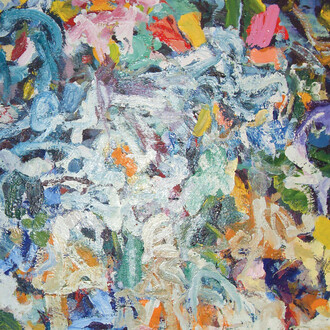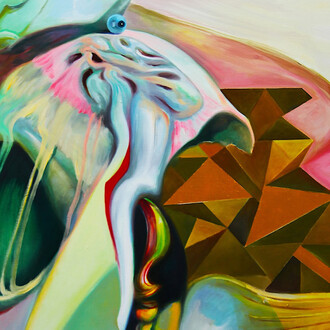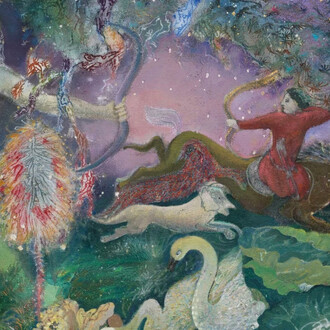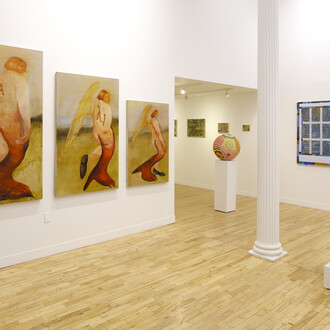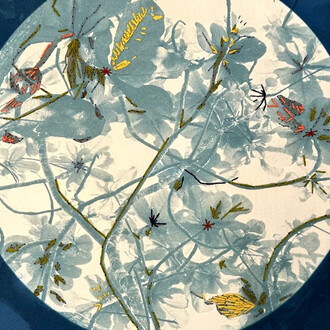Abstract art has evolved significantly over the years. Since our inception in 1982, the Anita Shapolsky gallery has been dedicated to showcasing and supporting artists who work in abstraction. We are excited to present a compelling blend of historical and contemporary abstract art in our upcoming exhibition Abstract Art Yesterday and Today.
(Anita Shapolsky)
Gallery 1: Seymour Boardman, Amy Ernst, Burt Hasen, Stanley Hayter, Jeanne Reynal, and Taro Yamamoto
Gallery 1 will feature the works of pioneering abstract artists Seymour Boardman, Amy Ernst, Burt Hasen, Stanley Hayter, Jeanne Reynal, and Taro Yamamoto. Each of these artists has made significant contributions to the development of abstract art, and their works reflect the diverse approaches and styles that have shaped the genre over time.
Seymour Boardman’s work was influenced by the European modernist tradition, particularly Cubism. After WWII Boardman spent time studying in Paris at the École des Beaux-Arts and the Atelier Fernand Léger. In his early work, Sy Boardman used grid-like structures with figurative references to urban architecture or the human body. In his later work, these patterns were deconstructed, and amorphous shapes emerged from a freely brushed ground, leading to more expressive and abstract forms. Amy Ernst is a contemporary American artist known for her mixed media works that often explore memory, identity, and abstraction themes. As the granddaughter of surrealist painter Max Ernst, she draws inspiration from her family’s artistic legacy and her innovative use of collage, printmaking, and found materials. She will be showing her unique painterly prints, created using specialized paper from the Center for Contemporary Printmaking in Norwalk, CT, where she has been working for 15 years. Burt Hasen was an American painter known for his surreal, dreamlike landscapes often incorporating abstract forms and elements of urban architecture.
Stanley William Hayter was a British printmaker and painter. He founded the influential Atelier 17 printmaking studio in Paris and later in New York, where he promoted experimentation and impacted a diverse group of international artists, including many women, such as Louise Nevelson and Perle Fine. The studio attracted prominent 20th-century figures like Miró, Calder, Picasso, Pollock, and Rothko. During WWII, while living in exile in New York, Hayter's style shifted from surrealism toward Abstract Expressionism, and his writings on Automatism influenced many American artists, including Jackson Pollock. Jeanne Reynal was an American mosaic artist. She combined the ancient art form with modern abstraction, creating dynamic, textured compositions using colored stones, glass, and cement. Taro Yamamoto was an American painter who studied at the Art Students League of New York and Hans Hofmann School of Fine Arts. He was associated with the New York School in the 1950s. Yamamoto’s paintings are known for gestural and geometric forms and action painting.
Gallery 2: Peter Bonner, Charles Clough, and Mark Gibian
Gallery 2 will highlight the work of artists from younger generations who are pushing the boundaries of abstraction today. This space will showcase the talents of Peter Bonner, Charles Clough, and Mark Gibian, whose work demonstrates the ever-evolving nature of abstract art in today’s technology-driven landscape.
Peter Bonner's paintings are characterized by their expressive use of color and gestural brushwork, capturing the dynamic interplay between memory and place. Charles Clough will show his Thumb paintings, adult abstract puzzle Clufffalo, and framed miniature paintings, alongside his recent explorations into slotted sculptures that evoke a playful engagement with form, reminiscent of paper dolls and soldiers. These works highlight Clough's inventive approach to abstraction and his continued experimentation with diverse mediums and techniques. Mark Gibian's small sculptures showcase his mastery of form and material on an intimate scale, often featuring delicate, interconnected elements that echo the fluidity and structural complexity of his large public works, inviting close examination and personal interaction.





